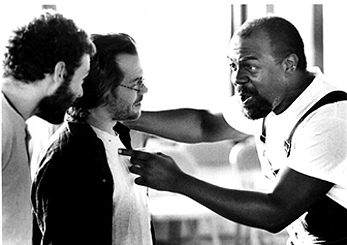








William Shakespeare's Hamlet: Prince of Denmark tells the story of a young prince who... Actually, eveyone already knows what he does, so lets get right on down to the particularities of the Oberlin version, which opened Wednesday night at Hall Auditorium.
Hamlet begins with the entire cast on stage portraying a frenzied group of hip, jazzy actors warming up for a run-through of the famous play. Although Shakespeare never conceived this epilogue, it fits into his tradition of narrative distance and breaking the fourth wall. Remaining in their contemporary clothing, the actors quickly jump into action.

Micheal Early, Oberlin Artist-in-Residence, plays the young prince in a contemplative, subtle manner, rising to the tip-toes of emotion when necessary. Early's training in dance shines as he ethereally wanders about stage, almost as if he were floating. This highly controlled approach has aspects of incredible beauty and Hamlet's princely nature is given a very unique and majestic underpinning.
The choice to costume Hamlet in a tattered red jump suit after his initial encounter with the Ghost is a very effective one, interestingly setting the Prince apart from the other characters and giving him a freedom to act as he would.
Also unique to this production is the element of the painted white face, which is commonly portrayed on the barrage of posters displayed on campus. However, it is difficult to understand exactly what the painted face suggests. Is it a comment on racism? Does it address the question of Hamlet's many "masks"? Or is it simply a rendition of a neutral mime mask? Later on, when additional players come out in white-face, the confusion is doubled.
Guest director Toby Robertson has set Hamlet on an empty stage, which can be a tricky thing - especially in Hall where the high ceiling and enormous width convey a false sense of depth. However, the dark abstracted stage is beautifully conceived by Robertson and scene designer Michael Louis Grube. The lighting also works nicely, never overstepping its bounds to illuminate annoying angles or crevices which can easily get picked up on an empty stage. The amazing shadows which accidentally get projected onto the ceiling are the exception, but add an extraordinary effect.
In collaboration, the empty stage, conservative lighting and simple costuming give the actors a golden opportunity to explore the endless layers and bizarre patterns of action and emotion which constitute the very subject-matter of this play. Indeed, the abstraction can be thought of as the actor's greatest challenge: to create illusion with no help from scenery. Unfortunately, this never comes to be. For the most part, the action is static and traditional.
We bear witness to the tired staging of simple triangles and fixed lines which have governed Shakespearean theater from its early years. The exceptional moments of beauty are when the actors submit their bodies to the language, rather than just their tongues. One such instance occurs when the Ghost, played by Equity actor Robert Beatty, embraces Hamlet's body in an interpretative dance of lathering-like motions, incensing the seeds of anger and revenge.
Other highlights of the play include senior Elizabeth Baron's tight and memorable grasp of the character Ophelia. In the scene where we witness her madness, she lets her body express her emotions. Barron's experience as a vocal major also helps her perform an especially eerie rendition of Ophelia's twisted songs. Polonius, played by Equity actor Glen Colerider, was exceptional and College junior Corey Stoll portrays a hilarious gravedigger. These are the times when the actors seem to move beyond their lines, when they have injected their bodies with electric action and wild emotion.
Unfortunately, these moments are rare, and for the most part, the action adheres with temerity to the oratorical recitation of a language that means very little on a black stage.
Playing the part: Robert Beatty, as Claudius, gives a few pointers to College sophomore Corey Stoill and Hutchins Foster, playing Rosencrantz and Guildenstern, respectively. (photo courtesy of John Seyfried)

Copyright © 1997, The Oberlin Review.
Volume 125, Number 13; February 7, 1997
Contact Review webmaster with suggestions or comments at ocreview@www.oberlin.edu.
Contact Review editorial staff at oreview@oberlin.edu.